Toural
GuimarãesSquares in Portugal

The Toural Square (Portuguese: Largo do Toural), commonly referred as just Toural, is the most important square and place of gathering on the Portuguese city of Guimarães. It began in the 17th century as a place to sell bulls (Touro in Portuguese), oxen and other goods. Unlike the rest of the city, pigeons aren’t commonly found in the Toural, but swallows are.
Excerpt from the Wikipedia article Toural (License: CC BY-SA 3.0, Authors, Images).Toural
Largo do Toural, Guimarães
Geographical coordinates (GPS) Address Nearby Places Show on map
Geographical coordinates (GPS)
| Latitude | Longitude |
|---|---|
| N 41.44191 ° | E -8.29562 ° |
Address
Largo do Toural
4810-442 Guimarães (Oliveira, São Paio e São Sebastião)
Portugal
Open on Google Maps











